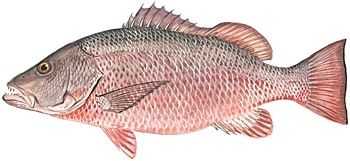Cubera Snapper

Species Details
Lutjanus Cyanopterus
Lutjanidae
Perciformes
Offshore
40 - 126 lbs.
36" - 63"
Cubera Snapper (Lutjanus cyanopterus) Fish Description
Also known as dog snapper, canteen snapper, Pacific snapper, and Cuban snapper, the Cubera Snapper is the largest of all snapper species. They are popular as game fish for anglers.
Cubera Snappers are easily confused with gray snappers . To distinguish them, one must look at the shape of the vomerine tooth patch found at the top of the palate; the Cubera Snapper has a triangular-shaped patch while the gray snapper, an anchor-shaped patch.
Cubera Snappers have elongated, slender bodies making them look almond-shaped. They possess seamless dorsal fins and long pectoral fins. They have thick lips, large mouths, and large canine teeth. Cubera Snappers generally have pale to dark gray or dark brown sides. They may also have some slightly reddish hues on their bodies, with a bluish tinge on their fins. They have some pale bars on the sides which eventually fade as they mature. The young Cubera Snappers are purplish-brown in color.
Diet and Size
Cubera Snappers love to eat crabs, lobsters, and ray-finned fishes. Their feeding grounds are usually located near the reefs or rocky areas of the ocean.
Cubera Snappers can weigh up to 120 pounds and grow up to 63 inches. Commonly, they weigh 40 pounds and measure up to 36 inches.
Interesting Facts About the Cubera Snapper
- Georges Cuvier was the first to document the Cubera Snappers in 1828.
- This species’ name, cyanopterus, translates to “bluefin” even though it only has hints of the color blue on its fins.
- Whale sharks, barracudas, and moray eels like to prey on newly spawned Cubera Snappers.
- Eating Cubera Snappers may lead to ciguatera poisoning caused by dinoflagellates or other algae and corals that the snappers may have ingested.
Fishing Techniques
Cubera Snappers can be fished at any time of the year both for commercial and recreational purposes. However, its status is currently “vulnerable” based on the IUCN Red List due to overfishing. The International Union for Conservation of Nature and Natural Resources (IUCN) monitors and evaluates the status of different species.
Anglers can catch cubera snappers using a live medium-sized fish like skipjack tuna. They are captured on rocky structures at most 150 feet deep. The anglers may also use squid as a lure at the tip of iron jigs; once the Cubera Snapper is hooked, the angler must pull fast and hold firmly because it is a strong fighter. In some cases, anglers can also allow them to enjoy the bait a little before reeling. Timing is important; letting the Cubera Snapper snack on the bait too long may allow them to escape back to the reefs and rocks.
The Cubera snappers spawn offshore on shallow waters from May to August. They are prone to overfishing during this period.
Habitat and Distribution
Cubera Snappers are native to the Amazon River; they can also be located in the western Atlantic Ocean, Caribbean Sea, Brazil, and the Gulf of Mexico.
They like reefs and rocky ledges and can be found in waters as deep as 180 ft. They thrive inshore or nearshore; the juvenile Cubera Snappers prefer the inshore mangrove areas to hide from predators. They also live in seagrass beds, freshwater canals, and estuaries.







